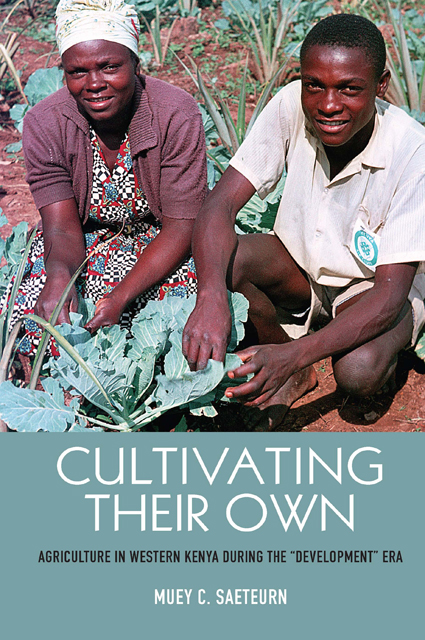Book contents
- Frontmatter
- Dedication
- Contents
- Acknowledgments
- Acronyms and Abbreviations
- Maps
- Introduction
- 1 The Role of Agriculture in Kenya’s Political Economy in the Era of Transition and Independence
- 2 Western Kenya’s Region, People, and the Origins of Population Density
- 3 Chavakali Secondary School: A Place of Learning and Farming
- 4 “Doing Their Part”: 4-K Farmers’ Clubs
- 5 Friends and Acres: The Friends Africa Mission Stewardship Program
- 6 “Home is Home”: The Lugari Settlement Scheme and Maragoliland
- Conclusion: Agricultural Production—The New (Old) Sexy
- Appendix: Interviewee Information
- Notes
- Bibliography
- Index
6 - “Home is Home”: The Lugari Settlement Scheme and Maragoliland
Published online by Cambridge University Press: 18 January 2023
- Frontmatter
- Dedication
- Contents
- Acknowledgments
- Acronyms and Abbreviations
- Maps
- Introduction
- 1 The Role of Agriculture in Kenya’s Political Economy in the Era of Transition and Independence
- 2 Western Kenya’s Region, People, and the Origins of Population Density
- 3 Chavakali Secondary School: A Place of Learning and Farming
- 4 “Doing Their Part”: 4-K Farmers’ Clubs
- 5 Friends and Acres: The Friends Africa Mission Stewardship Program
- 6 “Home is Home”: The Lugari Settlement Scheme and Maragoliland
- Conclusion: Agricultural Production—The New (Old) Sexy
- Appendix: Interviewee Information
- Notes
- Bibliography
- Index
Summary
I was just willing to come. I looked back at my family, there were five of us. Five sons. So, looking at the piece of land that was there, I realized that it [my father’s forty-one-acres of land] was kind of small [for everyone]. But, I realized that if I go to the settlement scheme and I get the fifteen-acres that means that I’ll be there alone [but] I would be having these fifteen-acres, so I told myself that I should just go.
On December 5, 1963, Nathan Molenje arrived to his assigned plot in the Lugari Settlement Scheme (LSS) to commence his new career as a full-time small-hold settler farmer. As his above comments suggest, Molenje was able to double the amount of land that his father was willing to provide him and his four brothers, which averaged about seven-acres for each son, by moving away from his family’s homestead and onto his own fifteen-acre settlement plot in the Checkalini sub-location of Lugari. He had acquired this significant piece of property as a participant of the Million Acre Scheme’s (MAS) high-density small-hold program. The Kenyan government had issued him a freehold title on which he was able to take out a mortgage for the property after he paid the required one hundred two shilling legal fee and stamp duty. Consequently, in the days leading up to Kenya’s sovereignty from Great Britain on December 12, 1963, Molenje was benefiting from the government’s ambitious project to develop the rural sector, especially its program for the people of Maragoliland.
The Ministry for Land Settlement and Water Development (LSWD), under the jurisdiction of the Kenya African Democratic Union (KADU) and Kenya African National Union (KANU) coalition government, began to plan the Lugari high-density small-hold project in May 1962. As a high-density settlement, LSS was to provide unemployed and landless Kenyans with land between ten and twenty-acres (depending on the soil quality) so that they could make a “decent” living in the post-colonial state. The planners of the Lugari scheme specifically intended the participants to come from subsistence and small-hold homesteads in the Maragoli and Bunyore locations of western Kenya’s North Nyanza district, a region that was predominately home to the people who identified as the Abaluhya.
- Type
- Chapter
- Information
- Cultivating their OwnAgriculture in Western Kenya during the 'Development' Era, pp. 126 - 151Publisher: Boydell & BrewerPrint publication year: 2020



